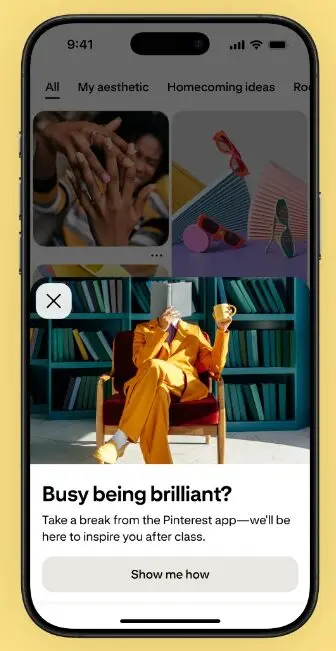- Pinterest expands wellbeing prompts to the UK, encouraging teens to close the app during school hours and mute notifications.
- Data shows 57% of UK teens want screen-time help, with many likening excessive phone use to health risks like poor diet or sun exposure.
- Over 1.3 million students engaged with earlier U.S. and Canadian tests, shaping the more casual, peer-like tone of the UK rollout.
- Pinterest positions itself ahead of regulation, as governments in Europe tighten rules on classroom phone use.
- Mental health groups welcome the move, calling on other platforms to follow Pinterest’s lead in promoting responsible digital habits.
The initiative reflects rising concern about youth mental health and excessive device use.
Pinterest is stepping into the debate over smartphones in classrooms by rolling out in-app prompts that encourage British teenagers to log off during school hours. The feature, introduced in time for the new academic year, signals how social platforms are increasingly being asked to address their role in managing digital distraction and supporting youth mental health.
According to Pinterest’s own data, teenagers in the UK spend an average of five hours per day on their phones. Nearly nine in ten say that devices get in the way of school focus or offline experiences, while 57% of 13–16-year-olds actively want tools to help them manage screen time.
These figures highlight why Pinterest’s initiative arrives at a critical moment, as parents, teachers, and policymakers debate how to balance technology’s benefits with its risks in education.
How the Prompts Work
The new feature displays a pop-up when students open Pinterest during typical school hours. Instead of simply warning them, the prompt takes on a more peer-like tone with phrases such as “busy being brilliant?” or “take a break.” It nudges students to close the app and mute notifications until classes are over.
The design is based on learnings from earlier rollouts in the U.S. and Canada. There, the platform became the first to test such proactive interventions, with 1.3 million students engaging with the feature in less than one month. Feedback from teens suggested that the language needed to feel less like it came from authority figures and more like encouragement from peers, leading Pinterest to fine-tune its messaging before expanding to the UK.
Check out the Pinterest Responds to AI Backlash: Introducing Gen AI Labels for Better Content Control
Why Pinterest Is Taking Action
The launch dovetails with broader societal anxiety about the impact of phones on young people’s attention spans and well-being. A majority of British teens surveyed by Pinterest compared phone overuse to other health risks: 54% said it was as harmful as eating junk food daily or ignoring sunscreen.
Pinterest CEO Bill Ready framed the move as a shared responsibility between tech companies and educators:
“In the classroom, students need the opportunity to learn without the constant distraction of apps on their phones. Limiting the use of phones in schools is a topic more prevalent than ever amongst educators and government, but to be truly effective, tech companies need to be part of the solution. Pinterest is setting out to support students, parents and teachers, who should not shoulder the responsibility alone.”
Mental health advocates have echoed this stance. Mark Rowland, Chief Executive of the Mental Health Foundation, praised the initiative:
“Digital platforms can offer opportunities for creativity, connection and self-expression. But they should be used in ways that support, rather than undermine mental health. School should be a place for learning and developing real-world relationships with peers. We call on other tech companies to follow Pinterest’s lead in making their own responsible contributions to protecting the mental health of our children and young people.”
The Broader Policy Landscape
Pinterest’s move arrives amid a wave of government-led restrictions on smartphones in education. France has already mandated phone lockaway policies for students, while Denmark and the Netherlands have rolled out bans. The UK is considering its own measures, with rising pressure on schools to curb mobile distraction and safeguard learning environments.
By introducing these prompts voluntarily, Pinterest positions itself as a platform ahead of regulation, aligning with trends toward responsible innovation. The initiative also reinforces Pinterest’s brand identity as a platform oriented around inspiration and creativity, rather than endless scrolling or heated discourse.
Implications for Platforms and Users
For students, the prompts provide a gentle nudge at a moment of temptation, offering what many teens already say they want—reminders to pause. For parents and teachers, the move signals that at least one major platform is taking its role in shaping healthier digital habits seriously.
For the wider tech industry, Pinterest’s experiment may create pressure for competitors to adopt similar well-being-first features.
Ultimately, the rollout highlights a shift in the metrics that matter. Rather than focusing solely on engagement, platforms are being asked to prove they can balance growth with responsibility—an expectation likely to shape future product design across the industry.




